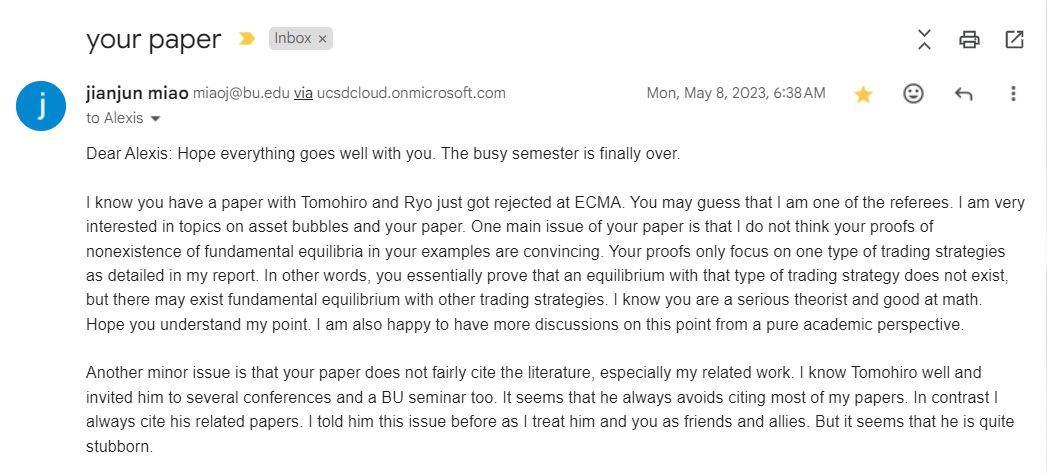👍Bubble Necessity Theorem
Published in Journal of Political Economy, 2025
In the fall of 2022, Tomohiro Hirano, Ryo Jinnai, and I studied a model in which the interaction between idiosyncratic investment risk, leverage, and the presence of a dividend-paying asset in fixed supply affects asset prices. Tomohiro and Ryo had already worked on asset price bubbles including Hirano and Yanagawa (2017) and Guerron-Quintana, Hirano, and Jinnai (2023), whereas it was a new topic for me. This collaboration led to the working paper of Hirano, Jinnai, and Toda (2023) “Necessity of Rational Asset Price Bubbles in Two-Sector Growth Economies”, which we posted to arXiv in November 2022.
We submitted the paper to Econometrica in January 2023. It was rejected on May 5, 2023. We had three reports. The first report, written by an expert, was on the fence but found the example of nonexistence of fundamental equilibrium (Proposition 2.2) “extremely surprising” and stated that
[the] interesting contribution of the paper is … to show that there might be settings where equilibria without bubbles do not exist.
The second report was likely written by a quantitative macroeconomist, declined to evaluate the theoretical contributions, and recommended rejection, while acknowledging that
What’s more of a surprise, is that under some conditions, we necessarily go to \(R=G\).
The third report was written by an expert and provided many comments. One of them was
Miao and Wang (2018, AER) … also study models of bubbles attached to assets with positive dividends/rents
and another was
I am not convinced by one of the main result of the paper that an equilibrium with rational asset price bubbles exists but equilibria with asset prices equal to fundamental values do not,
though this referee did not point out any specific mathematical error.
Three days later, on May 8, 2023, Jianjun Miao sent an email to me, in which he disclosed that he was the third referee at Econometrica.
In case it is difficult to read, I quote it here.
I know you have a paper with Tomohiro and Ryo just got rejected at ECMA. You may guess that I am one of the referees. I am very interested in topics on asset bubbles and your paper. One main issue of your paper is that I do not think your proofs of nonexistence of fundamental equilibria in your examples are convincing. Your proofs only focus on one type of trading strategies as detailed in my report. In other words, you essentially prove that an equilibrium with that type of trading strategy does not exist, but there may exist fundamental equilibrium with other trading strategies. I know you are a serious theorist and good at math. Hope you understand my point. I am also happy to have more discussions on this point from a pure academic perspective.
Another minor issue is that your paper does not fairly cite the literature, especially my related work. I know Tomohiro well and invited him to several conferences and a BU seminar too. It seems that he always avoids citing most of my papers. In contrast I always cite his related papers. I told him this issue before as I treat him and you as friends and allies. But it seems that he is quite stubborn.
The part “other trading strategies” is a bit strange, as our example employed a two-period overlapping generations model in which the unique portfolio choice in equilibrium is that the old sell the entire asset and the young buy the entire asset (which is necessarily true by market clearing). After this exchange, I offered to explain the proof in a Zoom meeting with Miao, but he insisted that a fundamental equilibrium (an equilibrium with \(P=V\)) always exists and was not willing to listen.
At this point, Tomohiro and I were not yet aware of the issues with Miao and Wang (2018) discussed in our clarification paper (subsequently published at Econ Journal Watch) or this post, but we were encouraged by the first referee’s reaction of “extremely surprising”, so we decided to write a new paper to establish the robustness of the nonexistence of fundamental equilibria. We worked intensively for a week and posted a new working paper “Bubble Necessity Theorem” to arXiv on May 14.
After polishing, we submitted this paper to Econometrica on June 21, 2023, this time attaching a cover letter detailing the conflict of interest with Miao. This paper was desk-rejected without any feedback from the editor: you can see the decision letter here.
Being worried if the cover letter was the cause of rejection, we then submitted the paper to Journal of Political Economy without a cover letter. Fortunately, we received a revision request on September 5, 2023 with three positive reports. After several revisions, the paper was accepted on April 23, 2024 and was published in 2025.
We will keep fighting for scientific integrity.

